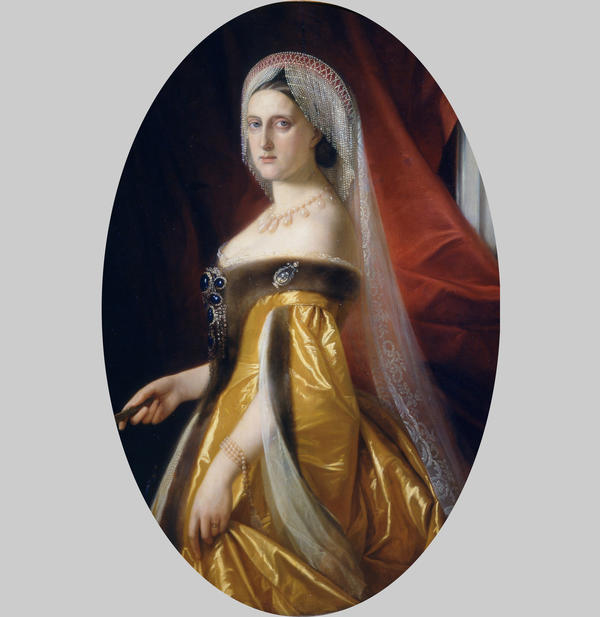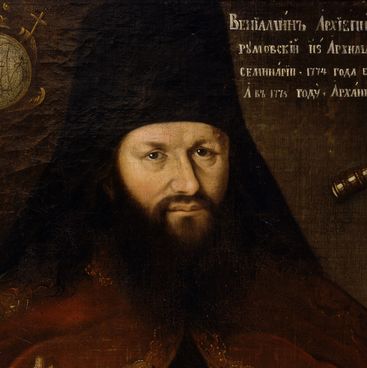The portrait features the Grand Duchess Maria Nikolaevna, the elder daughter of Russian Emperor Nicholas I. As remembered by her contemporaries, the grand Duchess took after her father both in a strong character and in her appearance. By the long-standing tradition of the Royal house, Tsar’s daughters were given in marriage to the heirs of the European royal families. Nevertheless, Maria Nikolaevna announced, she was not going to abandon her Motherland and chose Maximillian of Lichtenburg, who was in service in Russia, as her husband-to-be. The Duchess’s husband was a highly educated and learned person. Не possessed one of the best art collections in Europe. He was a connoisseur of the History of Arts and headed the Academy of Arts as its president.
Maria Nikolaevna inherited love for painting and a passion for collecting from her father. Following her husband’s early death, she took over heading the Academy of Arts, becoming its president. Anna Tyutcheva, maid of honour at the royal court, described the Duchess as “endowed with a remarkable intellect and an amazingly keen comprehension of painting and sculpture”. She pointed out that Maria Nikolaevna “greatly contributed to the flourishing of the Russian art”.
The Duchess is portrayed as a young determined and forceful woman. She is wearing a Russian formal court dress. By the act of 1834, Emperor Nicholas established the pattern of the court attire. During his reign, dresses were standardized by the style and trimming. The dress colour depended on the status of the court lady. The ceremonial attire consisted of an upper dress, typically made of velvet or some other valuable and expensive textile. In the front, there was a cut opening the white underskirt. The court ladies were required to wear a headdress, which could be a kokoshnik (headband) with a veil. Maria Nikolaevna is wearing an unbuttoned long-sleeved dress “a la boyar”; the headband of the Grand Duchess is adorned with fresh-water pearls.
As of now, the name of the painter is unknown. A similar portrait, created by artist Timofey Neff, was found in one of the halls of the Academy of Arts, which housed the portraits of the presidents of the Academy. This gave reasons to assume that the painting, displayed at the exhibition, was the artist’s replica of the original painting. However, the technological study of the canvas did not confirm this assumption.
Maria Nikolaevna inherited love for painting and a passion for collecting from her father. Following her husband’s early death, she took over heading the Academy of Arts, becoming its president. Anna Tyutcheva, maid of honour at the royal court, described the Duchess as “endowed with a remarkable intellect and an amazingly keen comprehension of painting and sculpture”. She pointed out that Maria Nikolaevna “greatly contributed to the flourishing of the Russian art”.
The Duchess is portrayed as a young determined and forceful woman. She is wearing a Russian formal court dress. By the act of 1834, Emperor Nicholas established the pattern of the court attire. During his reign, dresses were standardized by the style and trimming. The dress colour depended on the status of the court lady. The ceremonial attire consisted of an upper dress, typically made of velvet or some other valuable and expensive textile. In the front, there was a cut opening the white underskirt. The court ladies were required to wear a headdress, which could be a kokoshnik (headband) with a veil. Maria Nikolaevna is wearing an unbuttoned long-sleeved dress “a la boyar”; the headband of the Grand Duchess is adorned with fresh-water pearls.
As of now, the name of the painter is unknown. A similar portrait, created by artist Timofey Neff, was found in one of the halls of the Academy of Arts, which housed the portraits of the presidents of the Academy. This gave reasons to assume that the painting, displayed at the exhibition, was the artist’s replica of the original painting. However, the technological study of the canvas did not confirm this assumption.



